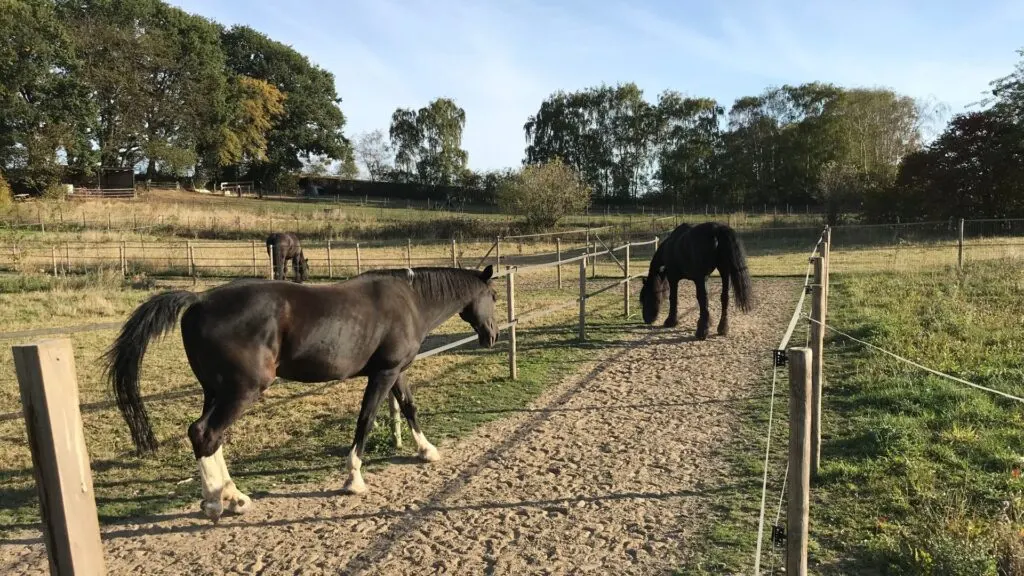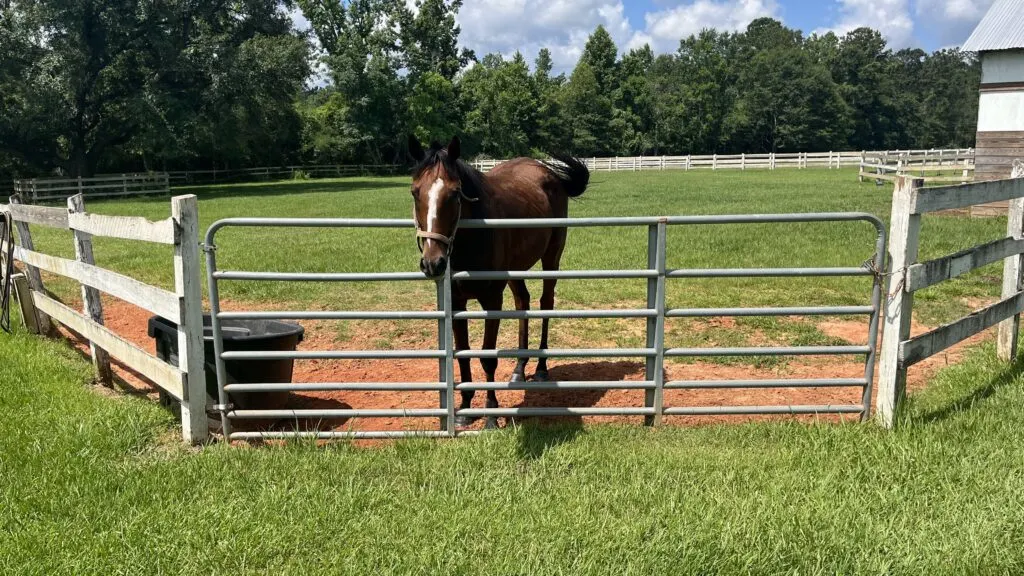Last updated: November 27, 2023
We have a paddock attached to our barn. It’s very similar to a small pasture, which confuses my grandson. He often asks me why we call it a paddock and why we don’t just turn the horses out into the big pastures.
Paddocks are fenced areas that are large enough for a horse to move freely but typically not so large that it can run. They are often used to separate horses, limit their movement, or control their diet. In horse racing, a paddock is where racehorses are saddled and paraded before the race.
Paddock sizes and shapes vary but are typically 20 by 60 feet and are indispensable on a horse farm.

Horse paddocks
Horse paddocks are typically attached to a barn and are accessed from a pasture gate or stall door. A paddock assessable from a stall is also called a runout.
A runout or paddock is especially useful for horses confined to stalls most of the day. You can open their stall to the paddock during certain times and allow the animal to move around outside to get fresh air and exercise.
What are paddocks used for?
Paddocks’ primary purpose is to separate horses without having to keep them cooped up in a stall. You may want to isolate a horse for many reasons, such as breeding purposes, recovering from an injury, or restricting its diet.

Paddocks can be useful to separate aggressive horses.
Any horse can be aggressive to other herd members; when this happens, it’s beneficial to have a paddock to separate the animals. Aggression is most often seen in stallions, but not exclusively.
Some horses are bullied and not permitted to eat. A passive horse can become ill because of the mistreatment by aggressive members of its herd.
Before things get out of hand, you can either feed your passive horse in the paddock or put the aggressive animal in the paddock and let the passive animal eat in peace.
Stallions are often kept in paddocks.
In horse breeding, a paddock is a pasture where stallions are kept apart from each other so that they cannot fight and disrupt the breeding process. The paddock is usually fenced off and has a shelter where the horses can rest and escape the elements.
The paddock also has a water source, such as a trough or pond, where the horses can drink. The stallions are kept in the paddock by themselves to prevent them from fighting and to allow the breeder to control their movements. The paddock is an important part of horse breeding farms and is essential for keeping the stallions calm and productive.
We recently brought two stallions to a friend’s farm because we didn’t have enough paddocks to separate our young horses from the fillies. We weren’t worried about them fighting but more concerned they would injure the young female horses.
You can use a paddock when horses are recovering from an injury.
Horses often have to be kept away from other horses when recovering from an injury. You can accomplish this by keeping a horse in a stall, but as the injured horse progresses, it may benefit from being turned out in a paddock for a couple of hours a day during recovery.
Paddock time allows the horse to build strength and get some fresh air before being reintroduced to the herd. We had a young horse that loved to run and play but had minor surgery and needed time for its stitches to heal.
We knew if it had a chance to get with its friends, they would chase each other around the pasture, and its incision would bust open. So we kept it in a stall at night and turned it out in a paddock until its incision healed enough to play safely.

Paddocks are useful when you need to restrict a horse’s diet.
Sometimes you may need to keep your horse off of pasture grass. There are numerous reasons to limit an animal’s grass intake. For example, performance horses often eat a strict diet, and their mineral, vitamins, and forage is controlled.
Other reasons may be because you have rich spring grass that isn’t fit for your horse, or maybe you’ve fertilized the field, and the grass isn’t suitable for your horse to eat at present.
Paddocks can help a horse transition to a stall.
A stall that opens to a paddock allows a horse to walk in and out of its stall. The free movement in and out of the stall helps horses uncomfortable with confinement transition to staying in a stall.
A stall with access to a paddock is especially useful for horses who lived their entire life in a pasture.
What size is a horse paddock?
How big does a horse paddock need to be? That depends on how you intend to use it. If you plan to use the paddock for one horse at a time, similar to a run-out, I suggest it doesn’t need to be any larger than 16 feet by 32 feet and could be even smaller.
Some horse owners design paddocks large enough to hold multiple horses. If this is your intent, I suggest the paddock be no smaller than 24 by 56 feet and possibly much larger depending on the number of horses you want it to house.

Horse paddocks cost
The cost of a paddock depends on the material you use and the size of your paddock. The budget equestrian explains how she built a small paddock for less than $500.00. You can click here to read the article.
She makes it work but expects to spend considerably more on most paddocks. A standard 16-foot by 32-foot paddock has three sides; one side opens to your barn.
I recommend building the paddock with posts eight feet apart and four boards. I would also recommend using treated 1×6 inches rough-cut if you can find them.
To build a paddock this size, 16 + 32 +32= 80 linear feet, with the material I described, will cost you approximately $1,000.00. I based the cost to build it at $12.00 per linear foot.
Once you have the per-foot cost, multiply the number by the total linear footage of the paddock you intend to build. It’s best to check with your local lumber company for prices in your area.
After you have the lumber prices, you can calculate the cost to build your paddock per foot. Of course, the price of materials changes quickly. The per square-foot cost I provided is an estimate to give you a general idea of a wooden four-board paddock’s cost.

How to keep horse paddocks dry
You want your horse’s feet to stay dry; too much moisture can lead to abscesses and other foot issues. The location and size of your horse paddock will dictate how to keep it dry. Some drain naturally and have a hard surface, while others drain poorly and are built over soft ground.
Our paddock is relatively small but has a nice clay foundation. Over this, we hauled in fine sand mixed with clay. This combination works well for our area, and it stays dry. We also have a portion of the paddock covered.
For a paddock to stay dry, the critical factor is drainage. Properly designed paddocks have good drainage; without it your paddock will be wet and messy.
The next most important consideration is surface material. Like I said earlier, we use sand, and it works well. When you choose a surface material for your paddock, keep in mind that the material must be easy to clean, non-toxic, and provides sound footing.
Sand, gravel, and clay, in combination, provide a solid base and, if set up correctly, drains well, is sanitary, and is easy to keep clean.

Horse paddock gates
The type and number of gates depend on the design of your paddock. I suggest that you have a minimum of two entrances, one opening to your pasture and one into your barn.
The gates should equal the height of the top board of your paddock fence. Also, the gate leading to the pasture should be at least 12 feet wide so that you can drive a tractor inside for maintenance.
A tractor with a box attached is excellent for spreading material, leveling, and pulling out debris. A wide gate also allows you to drive inside the paddock with your truck and trailer so you can load a horse inside the paddock.
Walk-through gates should be wide enough for your horse to pass through easily. The typical width is four feet, but a five-foot gate is even better. You can build paddock gates from wood, or you can buy pre-made pipe gates to your desired size.
Do you need horse paddock boots?
Paddock boots typically rise just above your ankles and have a suitable heel for riding. They are designed to work around the barn and horseback riding.
Paddock boots are typically comfortable, safe, and sturdy. They are made of various materials and come in numerous styles, such as lace-up, zip-up, and pull-on styles.
You can click on this link to find paddock boots sold on Amazon.

Below is a YouTube video that describes a horse paddock.
FAQ
What are paddocks at a horse racing track?
In horse racing, a paddock is an enclosed area where horses are saddled before a race. It is also where the jockeys mount. At most racetracks, spectators can watch the horses in the paddocks and pick their favorites.
Related articles:
- Can Horse Stalls Have Concrete Floors? Why Or Why Not
- What’s the Best Stall Bedding for Your Horse Barn? 4 Options
- How Big Does a Horse Stall Need to Be, and Why? 3 Examples
- What’s the Best Horse Barn Flooring: Stalls, Aisles, Tack Room
- 7 Best Horse Barn Fans For Stalls and Aisles
- Does a Horse Need a Barn? Shelter in a Pasture?
Meet Miles Henry
An avid equestrian and seasoned racehorse owner, Miles Henry brings his extensive experience to the equine world, proudly associating with the AQHA, The Jockey Club, and various other equine organizations. Beyond the racetrack, Miles is an accomplished author, having published various books about horses, and is a recognized authority in the field, with his work cited in multiple publications.
🔗 Connect with Miles:
Twitter
Facebook
YouTube: Check out race highlights, horse care tips, and more!


